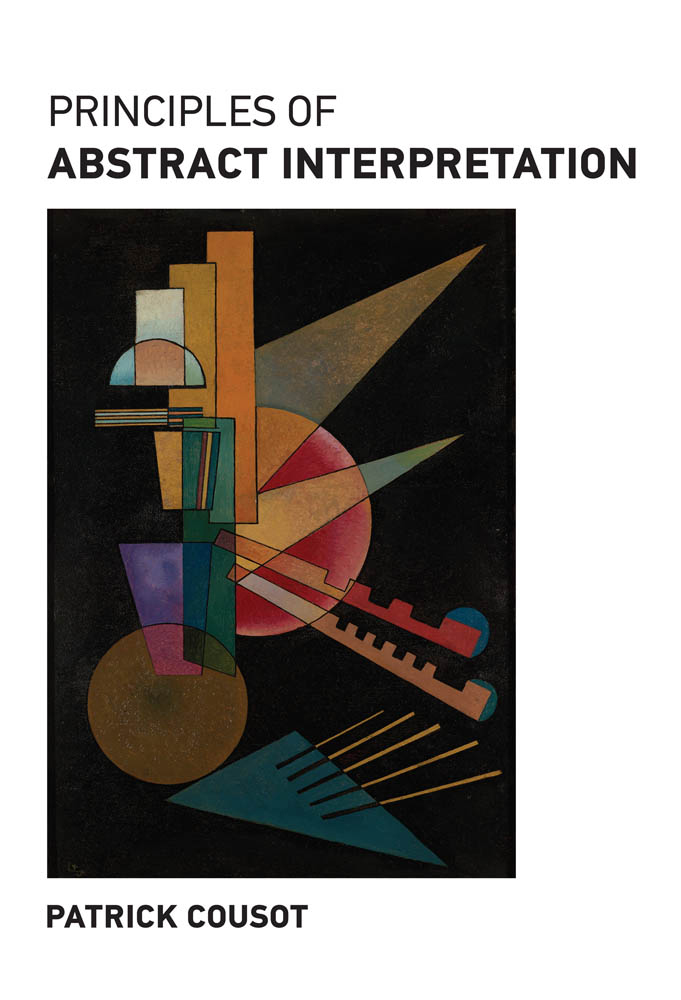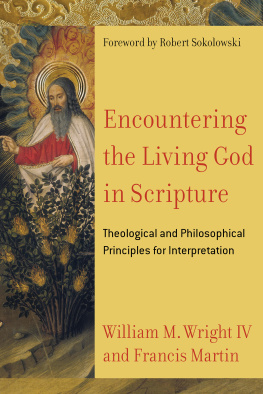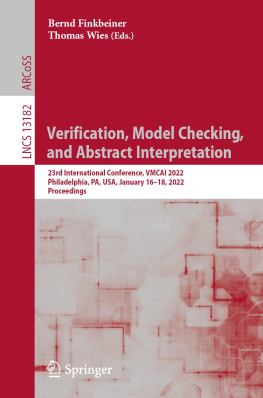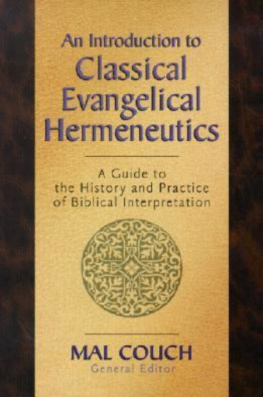Patrick Cousot - Principles of abstract interpretation
Here you can read online Patrick Cousot - Principles of abstract interpretation full text of the book (entire story) in english for free. Download pdf and epub, get meaning, cover and reviews about this ebook. year: 2021, publisher: MIT Press, genre: Children. Description of the work, (preface) as well as reviews are available. Best literature library LitArk.com created for fans of good reading and offers a wide selection of genres:
Romance novel
Science fiction
Adventure
Detective
Science
History
Home and family
Prose
Art
Politics
Computer
Non-fiction
Religion
Business
Children
Humor
Choose a favorite category and find really read worthwhile books. Enjoy immersion in the world of imagination, feel the emotions of the characters or learn something new for yourself, make an fascinating discovery.

- Book:Principles of abstract interpretation
- Author:
- Publisher:MIT Press
- Genre:
- Year:2021
- Rating:3 / 5
- Favourites:Add to favourites
- Your mark:
- 60
- 1
- 2
- 3
- 4
- 5
Principles of abstract interpretation: summary, description and annotation
We offer to read an annotation, description, summary or preface (depends on what the author of the book "Principles of abstract interpretation" wrote himself). If you haven't found the necessary information about the book — write in the comments, we will try to find it.
Principles of abstract interpretation — read online for free the complete book (whole text) full work
Below is the text of the book, divided by pages. System saving the place of the last page read, allows you to conveniently read the book "Principles of abstract interpretation" online for free, without having to search again every time where you left off. Put a bookmark, and you can go to the page where you finished reading at any time.
Font size:
Interval:
Bookmark:

Principles of Abstract Interpretation
Patrick Cousot
The MIT Press
Cambridge, Massachusetts
London, England
2021 2021 Massachusetts Institute of Technology
All rights reserved. No part of this book may be reproduced in any form by any electronic or mechanical means (including photocopying, recording, or information storage and retrieval) without permission in writing from the publisher.
Library of Congress Cataloging-in-Publication Data
Names: Cousot, Patrick, 1948 author.
Title: Principles of abstract interpretation / Patrick Cousot.
Description: Cambridge, Massachusetts: The MIT Press, [2021] | Includes bibliographical
references and index.
Identifiers: LCCN 2020041256 | ISBN 9780262044905
Subjects: LCSH: Semantic computing. | Abstract data types (Computer science)
Classification: LCC QA76.5913.C578 2021 | DDC 006dc23
LC record available at https://lccn.loc.gov/2020041256
d_r0
To Radhia Cousot, my daughters Camille and Rebecca, my sons Laurent and Thibault, and my grandchildren Margot, Sacha, Maxime, and Mal.
List of Figures
Syntax tree of the labeled program (4.1)
Labels of a statement
Upper closure operator
Higher-order Galois connection
Galois connection ,  , , upper closure operator , and lower closure operator
, , upper closure operator , and lower closure operator
Fixpoints of increasing and nonincreasing functions
Iteration
Continuity
Fixpoint abstraction
Transformer abstraction
Fixpoint overapproximation
Fixpoint abstraction
On commutation
Example of structural Hoare triple derivation
The congruence complete lattice
Interval complete lattice
Inductive and coinductive fixpoint iterations
Roy-Floyd-Warshall shortest distance algorithm
The Roy-Floyd-Warshall algorithm
Hierarchy of points-to static analyzers
The subsumption algorithm
The greatest lower bound algorithm
The least upper bound algorithm
Monomorphic typing rules
Monotype inference rules for expressions
Impossible failure
Possible success
After a short introduction to abstract interpretation (chapter 1), we provide a very minimal presentation of the core concepts of the theory and applications of abstract interpretation (chapter 3).
These core concepts of abstract interpretation can be presented as one or two classes of programming languages, compilation, program analysis, formal methods, or software engineering courses.
Before introducing abstract interpretation, we recall the basic concepts of set theory which are used almost everywhere in computer science and can be self-studied (chapter 2).
Contents
Since the beginning of computer science, in the 1940s, programmers have been writing programs that are increasingly powerful but still filled with errors. The most common method for tracking errors in programs is debugging. Run the program on as many data as possible and track for results that look incorrect. The obvious limitation is that only a finite number of casesindeed very fewcan be considered among all possible cases. Moreover, some properties cannot be checked in this wayfor example, that a program will never stop (unless interrupted).
Therefore, since the 1940s, great programmers have thought about writing programs without errors. Alan Turing [] and exemplified by programs of about 30 lines.
Things have changed a lot since then. Programs are much largermillions of lines are not uncommon. The program properties to be checked are much more complicated: for example, security and privacy properties that no one has yet been able to define precisely enough to anticipate all possible attacks and leaks. There are many more programmers, not all of them scientists as great as Alan Turing. Furthermore even computer hardware has bugs. Computer science applications are no longer created for a few scientists but are offered commercially to an extremely large public. Moreover, program bugs can and do kill people.
Still, debugging is going on. It is inexpensive, because it is performed mainly by end users who have no alternative to software that needs debugging. At root, programmers are not responsible for their errors. In addition, the no-warranty clause in software license agreements typically states that the licensor makes no guarantees regarding the utility, usability, accuracy, or performance of the software and related documentation or information. The software is provided as is, with faults, defects, errors and viruses and without warranty of any kind. The licensor does not warrant that the software will be free of bugs, errors, viruses, or other defects, and the licensor shall have no liability of any kind for the use of or inability to use the software, the software content, or any associated service.
This disgraceful Dantean situation is specific to computer science, in particular because of the lack of usable tools for engineers. Progress is needed. The final goal is to check programs for correctness without ever omitting a case that might go wrong. This is the ultimate, perhaps unfeasible, and surely not fully automatizable (see chapter 9) objective of formal methods.
Abstract interpretation [] for an informal introduction). It formalizes formal methods and allows discussing the guarantees they provide, such as soundness (the conclusions about programs are always correct under suitable explicitly stated hypotheses), completeness (all true facts are provable), or incompleteness (showing the limits of applicability of the formal method). For example, abstract interpretation explains the power and limits of debugging, deductive/proof/verification methods, model checking, static analysis, and so forth.
Abstract interpretation is applied mainly to design semantics, proof methods, and static analysis of programs. The semantics of a programming language formally defines all possible executions of its programs at various levels of abstraction. Proof methods can be used to prove (manually or using theorem provers) that the semantics of a program satisfies some specification, which is a property of executions defining what the program is supposed to do. Static analyzers are programs that automatically extract properties of programs semantics (i.e., properties of their executions) using only the program text, without running the programs on a computer.
The objective of this book is to introduce the theory of abstract interpretation and discuss its application to the semantics, specification, verification, and static program analysis of safety and security properties of programs. We focus on principles and breadth of applicability. We do not consider in great depth the algorithmic aspects (data structures and complexity); instead we refer to the literature for the improvement of the readers knowledge. The book is intended for readers interested in the theory of abstract interpretation, the understanding of formal methods, and the design of verifiers and static analyzers. For those interested only in the use of such static analyzers,
Font size:
Interval:
Bookmark:
Similar books «Principles of abstract interpretation»
Look at similar books to Principles of abstract interpretation. We have selected literature similar in name and meaning in the hope of providing readers with more options to find new, interesting, not yet read works.
Discussion, reviews of the book Principles of abstract interpretation and just readers' own opinions. Leave your comments, write what you think about the work, its meaning or the main characters. Specify what exactly you liked and what you didn't like, and why you think so.





